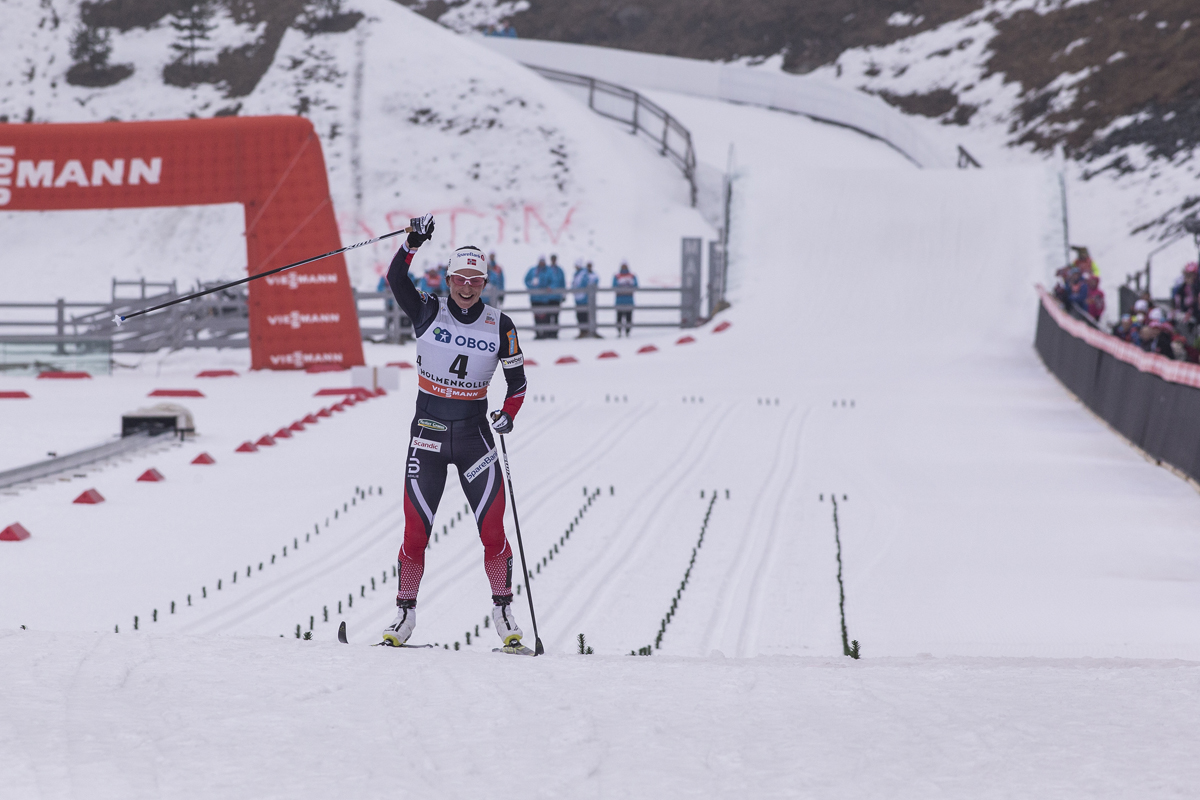
OSLO, Norway — The modernist Holmenkollbakken ski-jumping hill lords over the otherwise bucolic Holmenkollen ski venue. It’s certainly one of the wonders of the modern nordic sport world as the steel structure arcs elegantly toward the sky. At times during the men’s 50-kilometer classic mass start on Saturday at Holmenkollen, the sun glared off the jump, giving it the appearance of a polished silver spaceship.
During the women’s 30 k classic mass start on Sunday, fog descended onto the Holmenkollen neighborhood. The upper portions of the Holmenkollbakken jump, about a third of the structure, were lost in the clouds. Jumpers that flew from its heights before the start of the 30 k seemed to glide and fly out of the sky.

Those same clouds blanketed the high point of the 30 k course (with three 8.3 k laps and one 5 k lap) at Frognerseteren, where it seemed much of Oslo had stayed to party and welcome racers before their descent toward the stadium.
Each time Norway’s Marit Bjørgen rallied the hordes atop Frognerseteren, it was as if she appeared from the ether: Bjørgen’s race through the fog was a solo quest that ended in flat-out 30 k dominance.
Perhaps it’s splitting hairs saying exactly when this race was decided. Was it at 2.7 k when Bjørgen was up by nearly five seconds? For certain that was early on when anything was in play: wax, Bjørgen’s in-race nutrition, a potential fall. Was it her 33 second lead at 8 k? Was it her 1 minute and 22 second gap at 16.3 k?
By then this much was clear: Bjørgen was steamrolling. And yes, the race for first looked over.
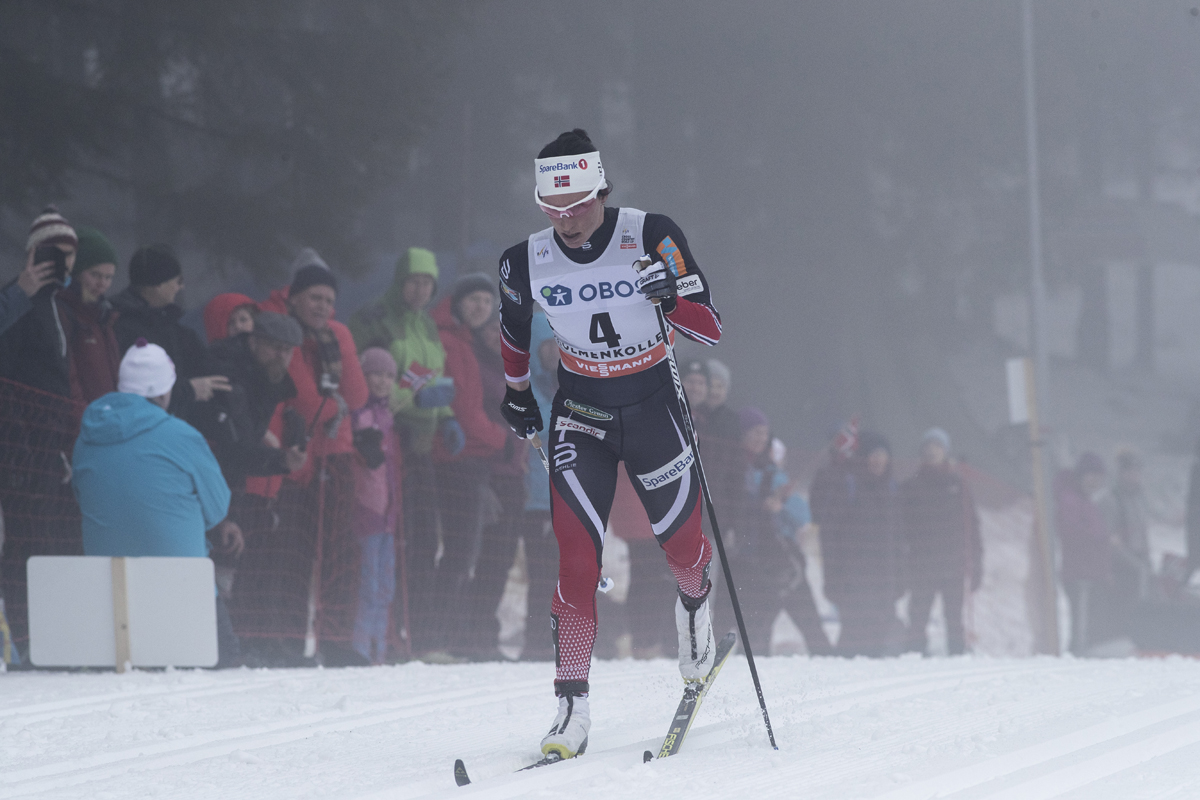
In her first Holmenkollen 30 k after taking a year off to start a family, Bjørgen, 36, looked peerless. On the stout Holmenkollen loop she only appeared to ratchet up the pace, firing with increasing power as the kilometers rolled.
Meters from the finish, Bjørgen bowed to the crowd and Norway’s King Harald V before stopping the clock at 1:22:59.2 hours to win her sixth Holmenkollen 30 k. Her nearest competitors were more than two minutes back.
Only a week ago, the 2017 Nordic World Championships wrapped up in Lahti, Finland. Bjørgen brought four golds home to Norway. She placed first in every distance event; the 15 k skiathlon, the 10 k classic individual start and the 30 k freestyle mass start. She also won gold as part of Norway’s 4 x 5 relay. In Lahti, she admitted to having pre-race nerves.
Those nerves weren’t apparent at Holmenkollen.
“I was more relaxed than I was in the World Championships,” Bjørgen said at the post-race press conference. “It was a different morning. Today I was waking up with my son, playing with him, and just going to the stadium, and yeah, it was more relaxing.”
A relaxed Bjørgen appears to be a potent Bjørgen.
“My plan was to try to go fast from the beginning if my body was feeling well, and it did,” Bjørgen added. “I had good skis also, when we passed 5 k, I heard 20 seconds. I understood I had to do my own race and, yeah, I feel good.”
Twelve times the Holmenkollen 30 k has been held after World Championships or the Olympics. Usually a two-week period elapses between those events. Bjørgen has won the 30 k back-to-back twice, but Sunday’s win makes it her first with only one week of recovery.
Evidently Bjørgen still recovers well, too.
“It has been not an easy week. I have been a little bit tired and the motivation has been hard really. I wanted to stay home with my son and play with him,” Bjørgen said. “But I trained a little bit and tried to relax and of course to go to the 30 k is a big motivation and you want to do well so it was no problem. I was wondering how the body was feeling, but today my legs were much better than it was earlier in the week.”
Chalk up another World Cup win.
Behind Bjørgen, it wasn’t so much a chase as an entirely separate race vying for the remaining podium spots. Playing off-Broadway to Bjørgen’s big show were Finland’s Krista Pärmäkoski, Kerttu Niskanen and Aino-Kaisa Saarinen, Norway’s Heidi Weng, Sweden’s Charlotte Kalla, and Poland’s Justyna Kowalczyk.
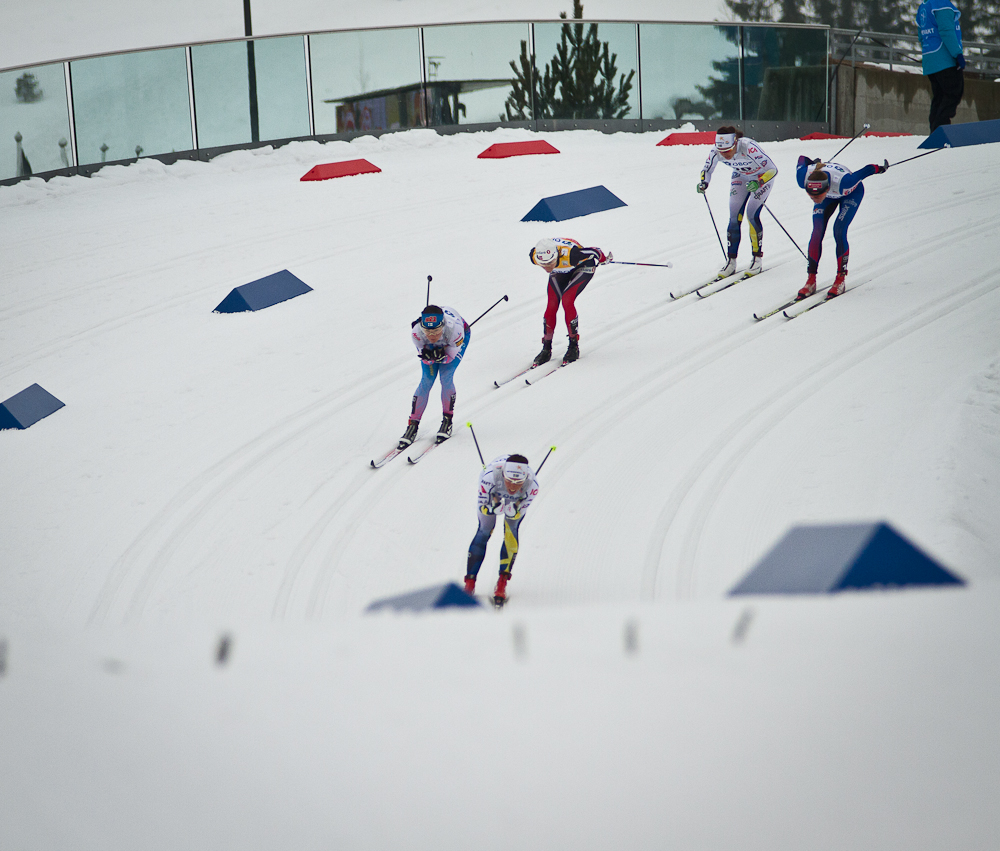
Throughout the 30 k race, it looked as if any one of those skiers could pull away into their own discrete chase for second. Kalla and Kowalczyk looked primed as they took a 14-second lead at the 16.3 k time check on the likes of Weng, Saarinen, Niskanen, and Pärmäkoski.
With that effort came an eventual catch. At 24.6 k, those six skiers came through just seconds apart. It wasn’t until the final stretch when place, not time, was part of every racer’s calculus and a separation of seconds occurred.
Finland took the remaining spots on the podium. Pärmäkoski placed second (+2:05.8), and teammate Niskanen was third (+2:07). Weng was fourth (+2:08.6), Kalla fifth (+2:11.7), Kowalczyk sixth (+2:12.9), and Saarinen — the last skier of the reputable first Bjørgen chase group — placed seventh (+2:19.6).
Just last Wednesday, Pärmäkoski placed second in the classic sprint in Drammen, Norway.
“Today [I] was feeling a little bit tired because that Drammen sprint was really good for me and last year also I had good race there,” Pärmäkoski said at the press conference. “But I am so happy that I am now stand on the podium on the sprint race and now of course this 30 k podium, the first on my career.”

Heading into the season-ending World Cup Finals, which will take place across the Atlantic in Quebec, Canada, Pärmäkoski sits second in the World Cup overall, exactly 300 points behind Norway’s Weng. Another Norwegian, Ingvild Flugstad Østberg, is 94 points behind Pärmäkoski in fourth. On Sunday, Østberg placed eighth (+2:31.3).
The U.S. Ski Team’s Kikkan Randall, like Bjørgen, has returned from a year away from skiing to start a family. Sunday was her first World Cup 30 k since she contested the 2014 Holmenkollen 30 k classic.
And on Sunday, Randall was the top American in 20th (+6:17.2).
“I had good energy,” Randall said of her race. “I kept a steady pace for me the whole way. 30 k was untested for me this year. I’m really happy. My expectation going into today, knowing where I’ve been in the last couple of weeks, I thought a top 20 was a good goal, and I just got that.”
With such a large hiatus between long-distance races at this level, Randall noted her sensations on the day were welcome.

“I skied a lot of threshold pace last year while I was pregnant, and a lot of it is coming back this summer, so maybe this is a good pace for me to ski right now,” Randall said. “The start was pretty fast, and I had a hard time staying up in the middle of the group, but I just skied a good, steady pace the whole way, and my energy stayed really strong. … It’s a great foundation to end this season with, knowing that I have a whole season next year to build that top-end speed back.”
Randall skied in a group that didn’t think twice about matching the turbo pace set from the starter’s gun. When the race shook out early on, Randall found her own race tempo and was able to eventually work up in the field.
“I felt like I got in a pack right away, maybe in the first 5 k, skiing with a pack of Norwegians, and we worked together most of the race, but pretty soon we were picking people off,” Randall explained. “The opening pace was hard, and I think a lot of the people who went with it suffered the consequences. It was kinda fun that we had little rabbits out there to go catch.”
Sadie Bjornsen, also of the U.S. Ski Team (USST), placed 24th on the day. Bjornsen skied much of her 30 k solo.
“I was trying to go with people from the start, to see what would happen,” Bjornsen said. “My best 30 k’s have been when I send it too hard, and somehow manage to keep up the pace. I tried for that, and I then I got a bit tired in the middle.”
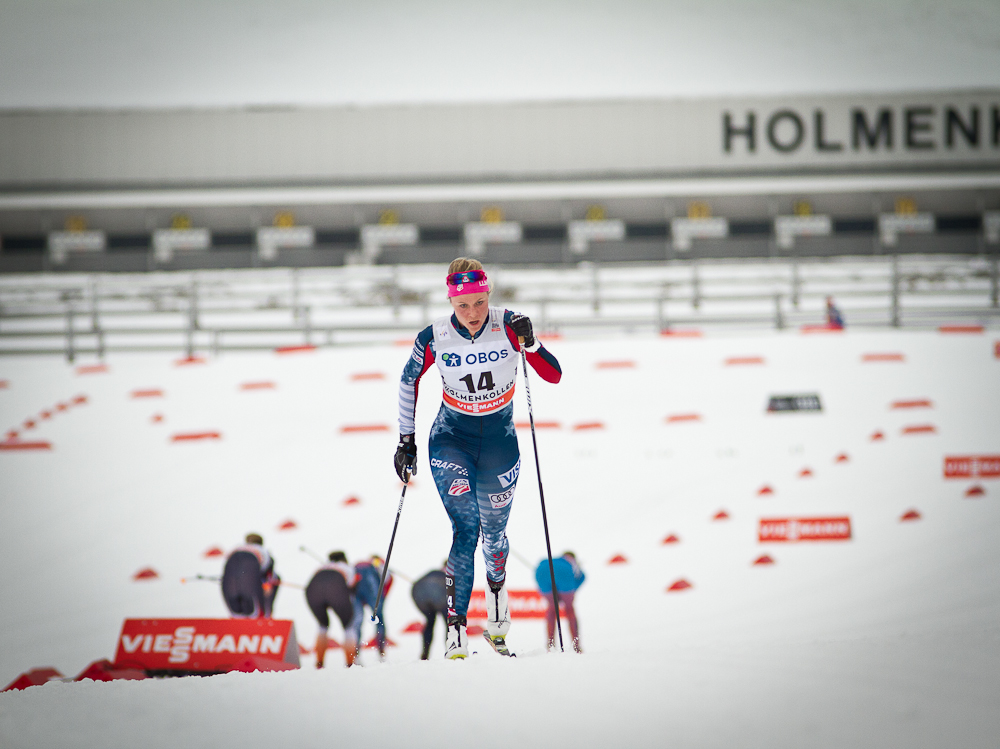
Bjornsen’s race was gritty, a go-for-it effort in a hallowed venue. Bjornsen noted she perhaps pushed too hard in spots and paid the price of fading.
“Today was one of those days that wasn’t the greatest, it wasn’t horrible, but you have to try,” Bjornsen explained.
Holmenkollen remains formidable.
“Holmenkollen is always the hardest race of the year, and I kind of love that,” Bjornsen said. “I’ve had some of my best and worst races here, and I think it’s fun to come here knowing that it’s going to be a challenge, but to also be excited for a challenge, because every time you finish this race, despite how you do, you have this feeling of total achievement, like, ‘Holy cow! I just skied 30 k on that course!’ It’s always hard … It’s just such an achievement to finish this race.”
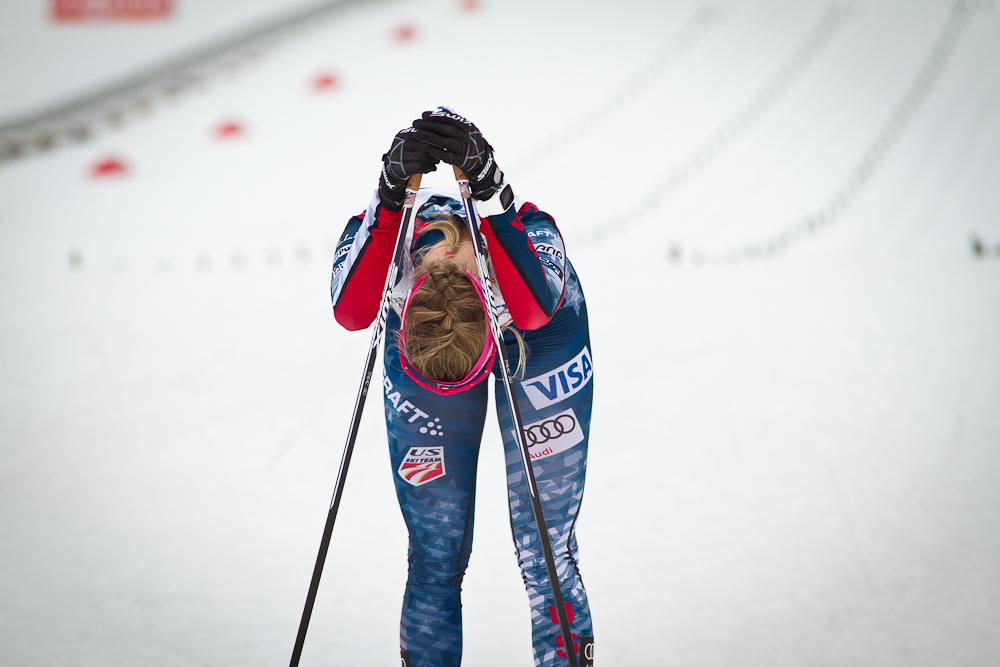
Also for the U.S., Liz Stephen (USST) finished 31st (+8:46.8) and Chelsea Holmes (Alaska Pacific University) 39th (+11:19.1). Rosie Brennan (USST) did not finish.
U.S. Ski Team Women’s Coach Matt Whitcomb explained that Brennan miscalculated with her initial pair of skis.
“Rosie struggled a bit with her first pair of skis,” Whitcomb wrote in an email. “I think she thought they were good in testing, but in the race they proved to be a little too slow. Her second pair was great after the exchange, but she was too far back and decided to pull. This was her decision and I support her. She wants to ski very well in Quebec, and these athletes don’t have much wick left to burn. This is a rare occurrence, and an exceptional reason for it to occur. She’ll be skiing with a vengeance in Quebec.”
No Canadian women entered Sunday’s 30 k.
Jason Albert
Jason lives in Bend, Ore., and can often be seen chasing his two boys around town. He’s a self-proclaimed audio geek. That all started back in the early 1990s when he convinced a naive public radio editor he should report a story from Alaska’s, Ruth Gorge. Now, Jason’s common companion is his field-recording gear.



